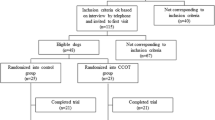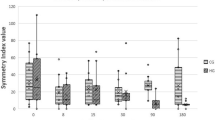Abstract
A study in young beagle dogs was performed in which the animals were treated for 2 weeks with ciprofloxacin at oral doses of 0, 10, 30 or 90 mg/kg per day. Immediately after treatment half of the number of animals were killed and all weight-bearing joints were subject to a thorough gross and histopathological investigation, including special staining of the cartilage matrix, and immunohistochemistry as well as electron microscopy. The remaining animals were maintained for an additional 5-months treatment-free period before being killed. Again, all weight-bearing joints were subject to a thorough gross and histopathological investigation. After 14 days of treatment with ciprofloxacin, oral doses of 30 and 90 mg/kg induced the characteristic arthropathy (blisters, erosions) in juvenile beagle dogs. As expected the lesions persisted while the animals were growing. In contrast, and to our knowledge demonstrated for the first time, an oral dose of 10 mg/kg ciprofloxacin did not induce joint lesions after short-term treatment in juvenile beagle dogs and was also not associated with arthrotoxicity when the dogs became older.








Similar content being viewed by others
References
Burkhart JE, Walterspiel JN, Schaad UB (1997) Quinolone arthropathy in animals versus children. Clin Infect Dis 25:1196–1204
Detzer K, Rühl C (1985) BAY o9867: Study of the systemic tolerability and the arthropathogenic action in beagles after oral administration over 4 weeks. Pharma-Report No. 13820, Bayer AG Wuppertal, data on file
Detzer K, Rühl C (1986) BAY o9867: Study of arthropathogenic effect in case of relief of joints after oral administration for 10 days to beagle dogs. Pharma-Report No. 14753, Bayer AG, Wuppertal, data on file
Ingham B, Brentnall DW, Dale EA, MacFadzean JA (1977) Arthopathy induced by antibacterial fused N-alkyl-3-pyridone-carboxylic acids. Toxicol Lett 1:21–26
Kappel EM, Shakibaei M, Bello A, Stahlmann R (2002) Effects of the des-F(6)-quinolone garenoxacin (BMS-284756), in comparison to those of ciprofloxacin and ofloxacin, on joint cartilage in immature rats. Antimicrob Agents Chemother 46:3320–3322
Kuehner SF (2000) Untersuchungen zur Chondrotoxizität von Ciprofloxacin und eines alimentär erzeugten Magnesiummangels beim Beagle-Hund. Inaugural-Dissertation. Fachbereich Humanmedizin der Freien Universität Berlin
Schaad UB (2000) Use of quinolones in pediatrics. In: Andriole VT (ed) The quinolones, 3rd edn. Academic Press, San Diego, pp 455–475
Shakibaei M, Foerster C, Merker H-J, Stahlmann R (1995) Effects of ofloxacin on integrin expression on epiphyseal mouse chondrocytes in vitro. Toxicol In Vitro 9:107–116
Stahlmann R (2003) Children as a special population at risk—quinolones as an example for xenobiotics exhibiting skeletal toxicity. Arch Toxicol 77:7–11
Stahlmann R, Lode H (1998) Safety overview. Toxicity, adverse effects and drug interactions. In: Andiole VT (ed) The quinolones, 2nd edn. Academic Press, San Diego, pp 369–414
Stahlmann R, Kühner S, Shakibaei M, Schwabe R, Flores J, Evander SA, Van Sickle DC (2000) Chondrotoxicity of ciprofloxacin in immature beagle dogs: immunohistochemistry, electron microscopy and drug plasma concentrations. Arch Toxicol 73:564–572
Takayama, S, Hirohashi M, Kato M, Shimada, H (1998) Toxicity of the quinolone antimicrobial agents. J Toxicol Environ Health 45:1–45
Tatsumi H, Senda H, Yatera S, Takemoto Y, Yamoyoshi M, Ohnishi K (1978) Toxicological studies on pipemidic acid. V. Effect on diarthrodial joints of experimental animals. J Toxicol Sci 3:357–367
von Keutz E, Christ W (1997) Toxicology and safety pharmacology of quinolones. In: Kuhlmann J, Zeiler HJ (eds) Handbook of experimental pharmacology, vol 127. Springer Berlin Heidelberg New York, pp 297–337
von Keutz E, Schlüter G (1999) Preclinical safety evaluation of moxifloxacin, a novel fluoroquinolone. J Antimicrob Chemother 43 [Suppl B]:91–100
Acknowledgements
The authors wish to thank Dr. E. Hartmann and her laboratory (Bayer HealthCare, PH-PDP-T Pathology) for the preparation of the immunohistochemical slides.
Author information
Authors and Affiliations
Corresponding author
Rights and permissions
About this article
Cite this article
von Keutz, E., Rühl-Fehlert, C., Drommer, W. et al. Effects of ciprofloxacin on joint cartilage in immature dogs immediately after dosing and after a 5-month treatment-free period. Arch Toxicol 78, 418–424 (2004). https://doi.org/10.1007/s00204-004-0551-6
Received:
Accepted:
Published:
Issue Date:
DOI: https://doi.org/10.1007/s00204-004-0551-6




